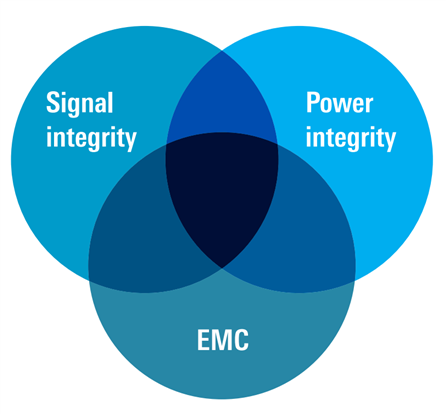Modern electronic designs increasingly integrate more functionality into less space. At the same time, processor speeds, clock and data rates are rising while signal levels are decreasing. All these developments result in a growing need for testing at the component, board and system level. Rohde & Schwarz offers several solutions to address testing requirements when developing, verifying and optimizing electronic designs.
With a deep understanding of design and manufacturing challenges, Rohde & Schwarz, with its market-leading expertise, is an ideal partner to tackle all aspects of EMC analysis, signal integrity as well as power integrity.
These are of fundamental importance in digital design.
EMC analysis
Passing EMC certification is a major milestone in the design process of any electronic product and a source of high risks and costs in the go-to-market strategy. Minimizing these risks and costs is crucial, which makes an early and consistent EMC test approach the key to success. For more information, see our earlier posts on EMI testing.
Signal integrity
Signal integrity is becoming increasingly important due to higher data rates and space-optimized embedded designs. The transition from parallel to serial bus interfaces has increased data rates, with 5 Gbps to 10 Gbps being common in many designs. Such complex designs are a challenge for today’s electronic engineers and may require a significant amount of time for debugging.
Active components. Digital interfaces have become predominant in electronic designs. Increasing data rates and clock speed, as well as omnipresent wireless connectivity create a need for highly sophisticated testing and debugging solutions. Signal integrity measurements are the key in the field of high-speed digital designs. It also plays a pivotal role in RF and microwave designs. Rohde & Schwarz offers market-leading phase noise testers, spectrum analyzers and advanced oscilloscopes for precise jitter and phase noise characterization in the frequency and time domain. Besides, signal and spectrum analyzers with excellent spectral purity, dynamic range and a wide analysis bandwidth for measuring spurious emissions are provided.
Passive components. Higher signal frequencies and data rates require top quality signal transmission paths in modern designs, including PCB traces, connectors and cables. Many different influencing factors, such as impedance mismatch and reflections, insertion loss, propagation delay, intra/ inter-pair skew, etc., are decisive for the overall quality of analog and digital signals. In this case, network analyzers are required to reliably determine the signal integrity of passive components.
Power integrity
Power delivery: Everything starts with the right voltage source. The requirements for power supplies are low noise and ripple as well as accurate and stable output voltage in order to introduce as little disturbance as possible. You can count on performance power supplies from Rohde & Schwarz like the R&SHMP2000, R&S
HMP4000 or R&S
NGP800 series to deliver clean and stable power to your electronic design.
Clean and stable power rail voltages are the basis for proper performance of any electronic design. The continuous demand for higher performance, higher level of integration and lower power consumption, as well as the constant trend towards lower voltage levels, higher data rates and smaller, more compact product dimensions, challenge engineers to ensure extremely stable and clean voltage supply in their electronic designs.
Designing for best power integrity requires extremely sensitive and accurate measurement. Measuring ripple, noise and transients on today’s low voltage DC power rails challenges most oscilloscopes. With smaller rail voltages and 1% to 2% tolerances, instrument and probing noise make it hard to accurately measure specified tolerances. Adequate bandwidth is required to see harmonics of fast edges and higher frequency sources that can be coupled on power rails.
Rohde & Schwarz, however, offers advanced oscilloscopes and probes to verify and analyze the remaining ripple and noise of your power rails. Ripple, noise and load-step response measurements on integrated circuits such as CPUs, DDR memories and FPGAs require very low noise and broadband probing solutions that can measure in the single-digit millivolt range. Qualifying the power supply for sensitive analog receiver circuits means measuring very small disturbances at relatively high DC offset levels.
To sum up, thorough measurements are needed – especially when you want to ensure proper system functionality, even under worst conditions. More detailed information about R&S test solutions for digital designs as well as insights about the companies’ powerful tools for system-level validation and debug of digital designs can be found here.

